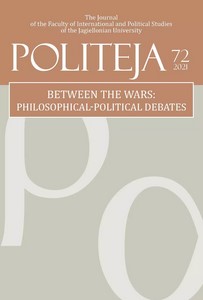THE HAMBURG CIRCLE. A THOROUGHLY STRUCTURED EXPRESSION OF THE GERMAN CONSERVATIVE REVOLUTION IN THE WEIMAR REPUBLIC
THE HAMBURG CIRCLE. A THOROUGHLY STRUCTURED EXPRESSION OF THE GERMAN CONSERVATIVE REVOLUTION IN THE WEIMAR REPUBLIC
Author(s): Joachim DiecSubject(s): History of Church(es), Political history, Government/Political systems, Political behavior, Politics and religion, Pre-WW I & WW I (1900 -1919), Interwar Period (1920 - 1939)
Published by: KSIĘGARNIA AKADEMICKA Sp. z o.o.
Keywords: conservative; revolution; Germany; Hamburg Circle; Weimar Republic;
Summary/Abstract: The members of the Hamburg Circle: W. Stapel (the leading figure), H. Bogner, A.E. Günther, G. Günther, are usually attributed to the ‘young conservative’ trend of the conservative revolution in the Weimar Republic. The main platform of their expression was the Deutsches Volkstum, a monthly published in Hamburg between 1898 and 1938. The activists of the circle opposed the realities of the Weimar Republic, negating the foundations of a democratic and liberal society as it did not express the ‘national will’ of Germans. Their ideal was not exactly in the revival of monarchy but they proposed a national state which was supposed to promote the traditionally structured society. In the area of religious policy, Stapel and his colleagues aimed at a non-secular state with a form of traditionalistic church life in spite of the religious diversity in Germany. Christianity was not perceived from a purely spiritual perspective, but as a doctrine that should be a strong pillar of the state. The Hamburg Circle claimed that to achieve these goals Germans ought to reject liberalism and pacifism, which appeared to be a dangerous consequence of the ideological pressure from assimilated Jewry.
Journal: Politeja - Pismo Wydziału Studiów Międzynarodowych i Politycznych Uniwersytetu Jagiellońskiego
- Issue Year: 18/2021
- Issue No: 72
- Page Range: 103-128
- Page Count: 26
- Language: English

